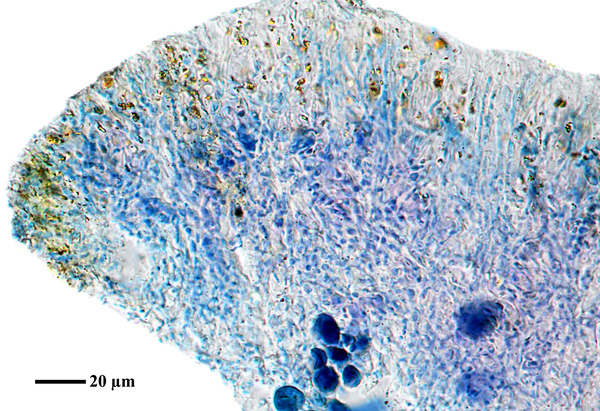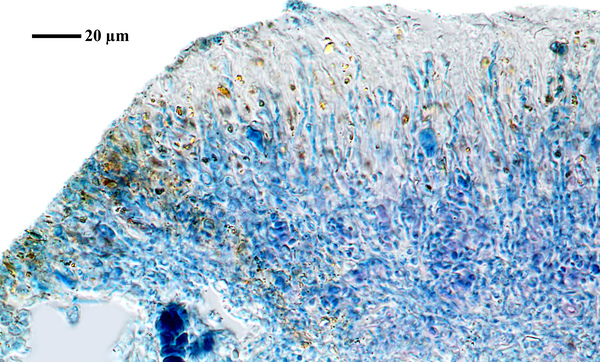Caloplaca adriatica (Zahlbr.) Servít
Hedwigia, 71: 275, 1931. Basionym: Caloplaca schaereri var. adriatica Zahlbr. - Ann. naturhist. Mus. Wien, 19: 420, 1904
Synonyms:
Distribution: N - VG, Ven (Nascimbene 2003b, 2005c, Nascimbene & Marini 2007), TAA (Spitale & Nascimbene 2012), Lig (Giordani & al. 2016). C - Abr (Nimis & Tretiach 1999). S - Cal (Puntillo 1996).
Description: Thallus crustose, episubstratic, well-delimited, bright yellow, rather thin, usually rimose-areolate. Apothecia 0.2-0.8(-1) mm across, at first immersed, then sessile, with a flat, rust-orange to orange-brown disc and a rather thick, paler orange proper margin which tends to disappear in mature apothecia. Proper exciple orange in outer part, colourless within, the pigmented part K+ purple-red; epithecium with yellow-brown crystals, K+ purple-red; hymenium and hypothecium colourless; paraphyses usually unbranched, enlarged at apex. Asci 8-spored, clavate, functionally unitunicate, apically thickened with a broad internal beak, the inner part of apex and external cap I+ blue, Teloschistes-type. Ascospores 2-celled, polarilocular, hyaline, ellipsoid, 9-13 x 3-4(-6.5) µm, the equatorial thickening (“septum”) 1-2.5(-3) µm, c. 1/2 of spore length. Photobiont: chlorococcoid. Spot tests: thallus and apothecia K+ purple-red, C-, KC-, P-. Chemistry: thallus and apothecia with unidentified anthraquinones. Note: a Mediterranean to mild-temperate lichen found on steeply inclined surfaces of hard limestone rocks.
Growth form: Crustose endolithic
Substrata: rocks
Photobiont: green algae other than Trentepohlia
Reproductive strategy: mainly sexual
Commonnes-rarity: (info)
Alpine belt: absent
Subalpine belt: absent
Oromediterranean belt: absent
Montane belt: very rare
Submediterranean belt: extremely rare
Padanian area: absent
Humid submediterranean belt: extremely rare
Humid mediterranean belt: absent
Dry mediterranean belt: absent
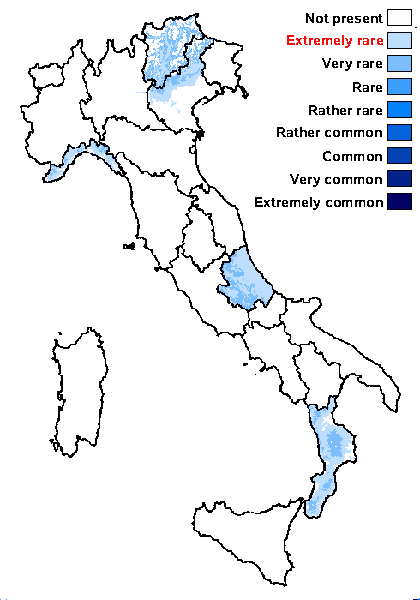
Predictive model
Herbarium samples
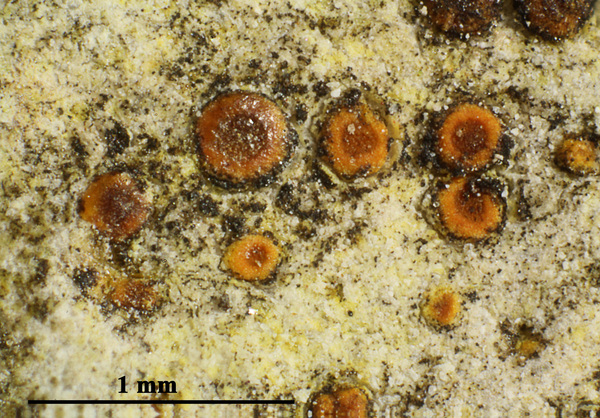

Felix Schumm - CC BY-SA 4.0
[19564], Gallia, Vaucluse, Lafare, in praerupta La Salle dicta, alt. 400 m, ad parietem altum rupis calcareae. Leg. G. Clauzade et Cl. Roux, 8.01.1976. VEZDA: LICHENES SELECTI EXSICCATI NR. 1419.


P.L. Nimis; Owner: Department of Life Sciences, University of Trieste
Herbarium: TSB (11674)
2002/12/02
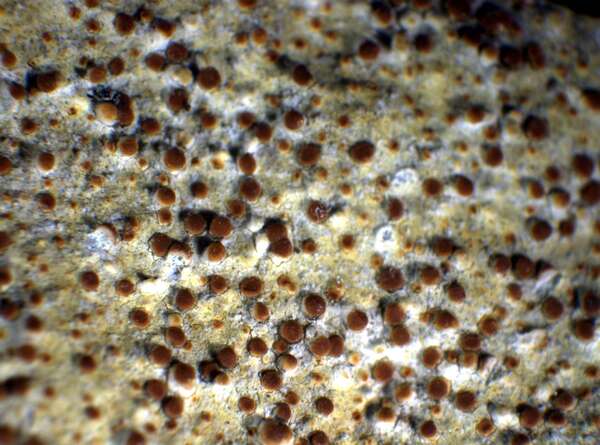

P.L. Nimis; Owner: Department of Life Sciences, University of Trieste
Herbarium: TSB (11674)
2001/11/19
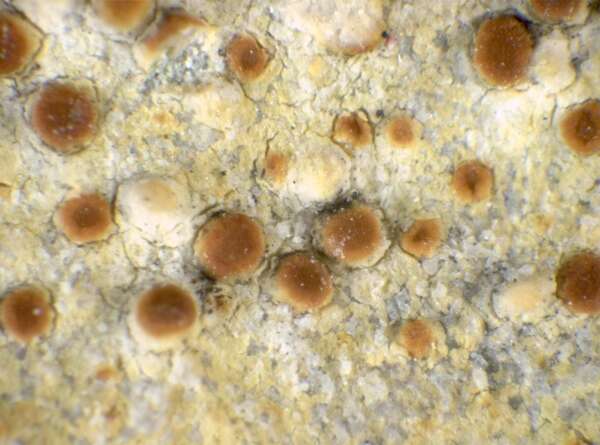

P.L. Nimis; Owner: Department of Life Sciences, University of Trieste
Herbarium: TSB (11674)
2001/12/18
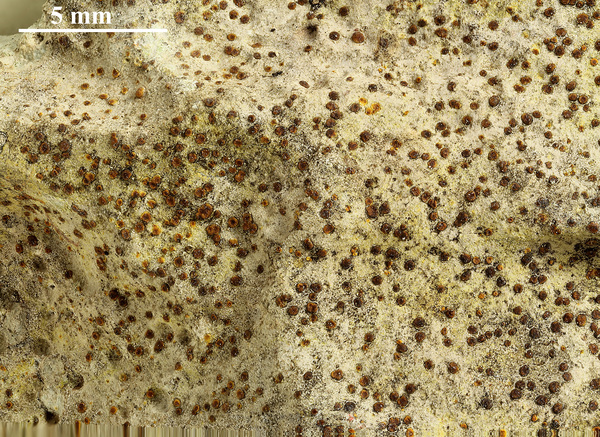

Felix Schumm - CC BY-SA 4.0
[19564], Gallia, Vaucluse, Lafare, in praerupta La Salle dicta, alt. 400 m, ad parietem altum rupis calcareae. Leg. G. Clauzade et Cl. Roux, 8.01.1976. VEZDA: LICHENES SELECTI EXSICCATI NR. 1419.


Felix Schumm - CC BY-SA 4.0
[19564], Gallia, Vaucluse, Lafare, in praerupta La Salle dicta, alt. 400 m, ad parietem altum rupis calcareae. Leg. G. Clauzade et Cl. Roux, 8.01.1976. VEZDA: LICHENES SELECTI EXSICCATI NR. 1419.
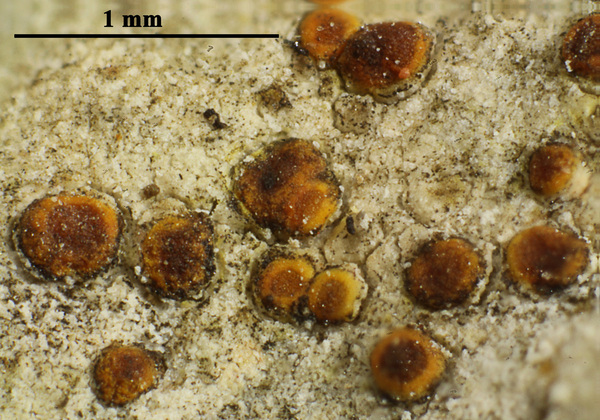

Felix Schumm - CC BY-SA 4.0
[19564], Gallia, Vaucluse, Lafare, in praerupta La Salle dicta, alt. 400 m, ad parietem altum rupis calcareae. Leg. G. Clauzade et Cl. Roux, 8.01.1976. VEZDA: LICHENES SELECTI EXSICCATI NR. 1419.
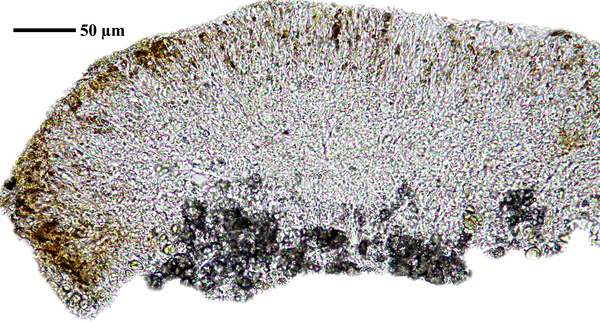

Felix Schumm; Owner: Felix Schumm - CC BY-SA 4.0
[19564], Gallia, Vaucluse, Lafare, in praerupta La Salle dicta, alt. 400 m, ad parietem altum rupis calcareae. Leg. G. Clauzade et Cl. Roux, 8.01.1976. VEZDA: LICHENES SELECTI EXSICCATI NR. 1419
Growth form: Crustose endolithic
Substrata: rocks
Photobiont: green algae other than Trentepohlia
Reproductive strategy: mainly sexual
Commonnes-rarity: (info)
Alpine belt: absent
Subalpine belt: absent
Oromediterranean belt: absent
Montane belt: very rare
Submediterranean belt: extremely rare
Padanian area: absent
Humid submediterranean belt: extremely rare
Humid mediterranean belt: absent
Dry mediterranean belt: absent

Predictive model
| Herbarium samples |


Felix Schumm - CC BY-SA 4.0
[19564], Gallia, Vaucluse, Lafare, in praerupta La Salle dicta, alt. 400 m, ad parietem altum rupis calcareae. Leg. G. Clauzade et Cl. Roux, 8.01.1976. VEZDA: LICHENES SELECTI EXSICCATI NR. 1419.


P.L. Nimis; Owner: Department of Life Sciences, University of Trieste
Herbarium: TSB (11674)
2002/12/02


P.L. Nimis; Owner: Department of Life Sciences, University of Trieste
Herbarium: TSB (11674)
2001/11/19


P.L. Nimis; Owner: Department of Life Sciences, University of Trieste
Herbarium: TSB (11674)
2001/12/18


Felix Schumm - CC BY-SA 4.0
[19564], Gallia, Vaucluse, Lafare, in praerupta La Salle dicta, alt. 400 m, ad parietem altum rupis calcareae. Leg. G. Clauzade et Cl. Roux, 8.01.1976. VEZDA: LICHENES SELECTI EXSICCATI NR. 1419.


Felix Schumm - CC BY-SA 4.0
[19564], Gallia, Vaucluse, Lafare, in praerupta La Salle dicta, alt. 400 m, ad parietem altum rupis calcareae. Leg. G. Clauzade et Cl. Roux, 8.01.1976. VEZDA: LICHENES SELECTI EXSICCATI NR. 1419.


Felix Schumm - CC BY-SA 4.0
[19564], Gallia, Vaucluse, Lafare, in praerupta La Salle dicta, alt. 400 m, ad parietem altum rupis calcareae. Leg. G. Clauzade et Cl. Roux, 8.01.1976. VEZDA: LICHENES SELECTI EXSICCATI NR. 1419.


 INDEX FUNGORUM
INDEX FUNGORUM
 GBIF
GBIF
 DOLICHENS
DOLICHENS
